Malbone Street Wreck

Remains of the wreck
|
|
| Date | November 1, 1918 |
|---|---|
| Time | 6.42 p.m. |
| Location | Flatbush, Brooklyn |
| Country | United States |
| Rail line | Brighton Beach Line |
| Operator | Brooklyn Rapid Transit Company |
| Type of incident | Derailment |
| Cause | Excessive speed round curve |
| Statistics | |
| Trains | 1 |
| Deaths | 93–102 |
The Malbone Street Wreck, also known as the Brighton Beach Line Accident of the Brooklyn Rapid Transit Company (BRT), was a rapid transit railroad accident that occurred November 1, 1918, beneath the intersection of Flatbush Avenue, Ocean Avenue, and Malbone Street (now known as Empire Boulevard), in the community of Flatbush, Brooklyn. At least 93 people died, making it one of the deadliest train crashes in the history of the United States, as well as the deadliest in the history of the New York City Subway.
The wreck occurred the evening of November 1, 1918 at 6:42 PM, during the last days of World War I. An elevated train, consisting of five cars constructed primarily of wood, entered the tunnel portal beneath Malbone Street going toward the Prospect Park station, negotiating a curve designated to be taken at 6 miles per hour (10 km/h) at a speed estimated at between 30 and 40 mph (48 and 64 km/h). The trailing truck of the first car derailed, and the two following cars completely left the tracks, tearing off their left-hand sides and most of their roofs. The first and fourth cars sustained relatively minor damage, while the second and third cars were severely damaged, the third so badly that it was dismantled on the spot. The fifth suffered no damage at all. The motorman was not injured and left the scene of the accident.
The Malbone Street Wreck was not caused by any single event or failure, but a series of individual circumstances, the omission of any one of which might have prevented the accident or at least reduced its severity:
The Brotherhood of Locomotive Engineers (BLE), representing some of the motormen operating elevated trains of the BRT, went on strike from the company on the morning of November 1 over issues involving union organization and the discharge from employment of a number of BLE members. This created a shortage of motormen to operate the system.
...
Wikipedia
